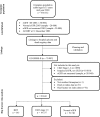Hip fracture incidence and mortality in chronic kidney disease: the GLOMMS-II record linkage cohort study
- PMID: 29654031
- PMCID: PMC5898333
- DOI: 10.1136/bmjopen-2017-020312
Hip fracture incidence and mortality in chronic kidney disease: the GLOMMS-II record linkage cohort study
Abstract
Background: Individuals on renal replacement therapy (RRT) have increased fracture risk, but risk in less advanced chronic kidney disease (CKD) is unclear.
Objective: To investigate CKD associations with hip fracture incidence and mortality.
Design: Record linkage cohort study Grampian Laboratory Outcomes Mortality and Morbidity Study II.
Setting: Single health region in Scotland.
Participants: All individuals (≥15 years) with sustained CKD stages 3-5 and those on RRT, and a 20% random sample of those with normal renal function, in the resident population in 2003.
Outcome measures: Outcomes were (1) incident hip fracture measured with (A) admissions or (B) deaths, with at least 5.5 years follow-up and (2) post-hip fracture mortality. Unadjusted and adjusted, incident rate ratios (IRRs) and mortality rate ratios were calculated using Poisson regression.
Results: Of 39 630 individuals identified in 2003 (41% males, mean age 63.3 years), 19 537 had CKD stages 3-5, 345 were on RRT and 19 748 had normal estimated glomerular filtration rate (eGFR). Hip fracture incidence, measured by admissions, was increased in CKD stages 3-5 (compared with normal eGFR), both overall (adjusted IRR 1.49 (95% CI 1.24 to 1.79)) and for individual CKD stages 3a, 3b and 4. Hip fracture incidence, measured using deaths, was increased in those with CKD stages 3b and 4. Post-hip fracture mortality was only increased in CKD stage 4. There was only a small number of individuals and events for CKD stage 5, resulting in insufficient statistical power.
Conclusion: Hip fracture incidence was higher in CKD stages 3-5 compared with normal eGFR. Post-hip fracture mortality was only increased in CKD stage 4. Reducing hip fracture incidence in CKD through regular fall and fracture risk review should reduce overall deaths after hip fracture in the population.
Keywords: chronic kidney disease; cohort; death; hip fracture; incidence; mortality.
© Article author(s) (or their employer(s) unless otherwise stated in the text of the article) 2018. All rights reserved. No commercial use is permitted unless otherwise expressly granted.
Conflict of interest statement
Competing interests: LR was supported by NHS Grampian Endowment (grant no: 14/30).
Figures


References
-
- National Institute for Health and Care Excellence. The management of hip fracture in adults. London: National Clinical Guideline Centre, 2011.
-
- Scottish Intercollegiate Guidelines Network (SIGN). Management of hip fracture in older people. A national clinical guideline. Edinburgh: Scottish Intercollegiate Guidelines Network, 2009.
-
- Royal College of Physicians. National Hip Fracture Database (NHFD) annual report 2016. London: Royal College of Physicians, 2016.
Publication types
MeSH terms
Grants and funding
LinkOut - more resources
Full Text Sources
Other Literature Sources
Medical
Research Materials
Miscellaneous
